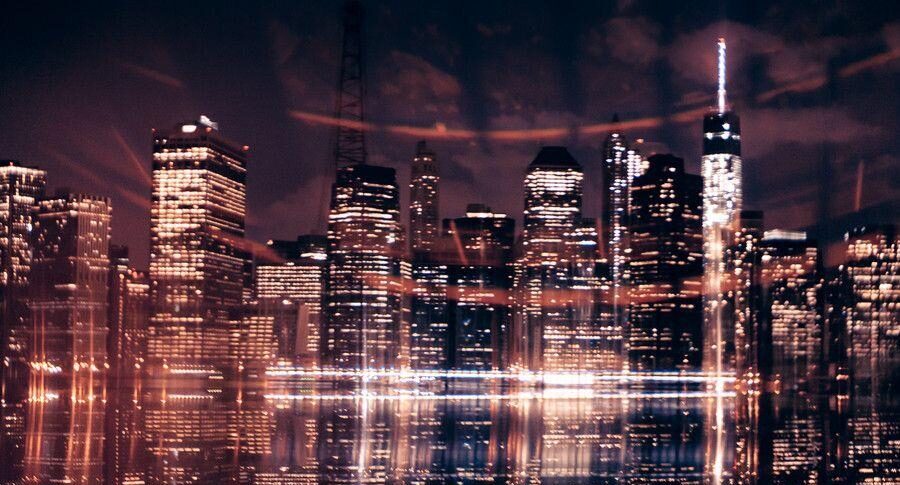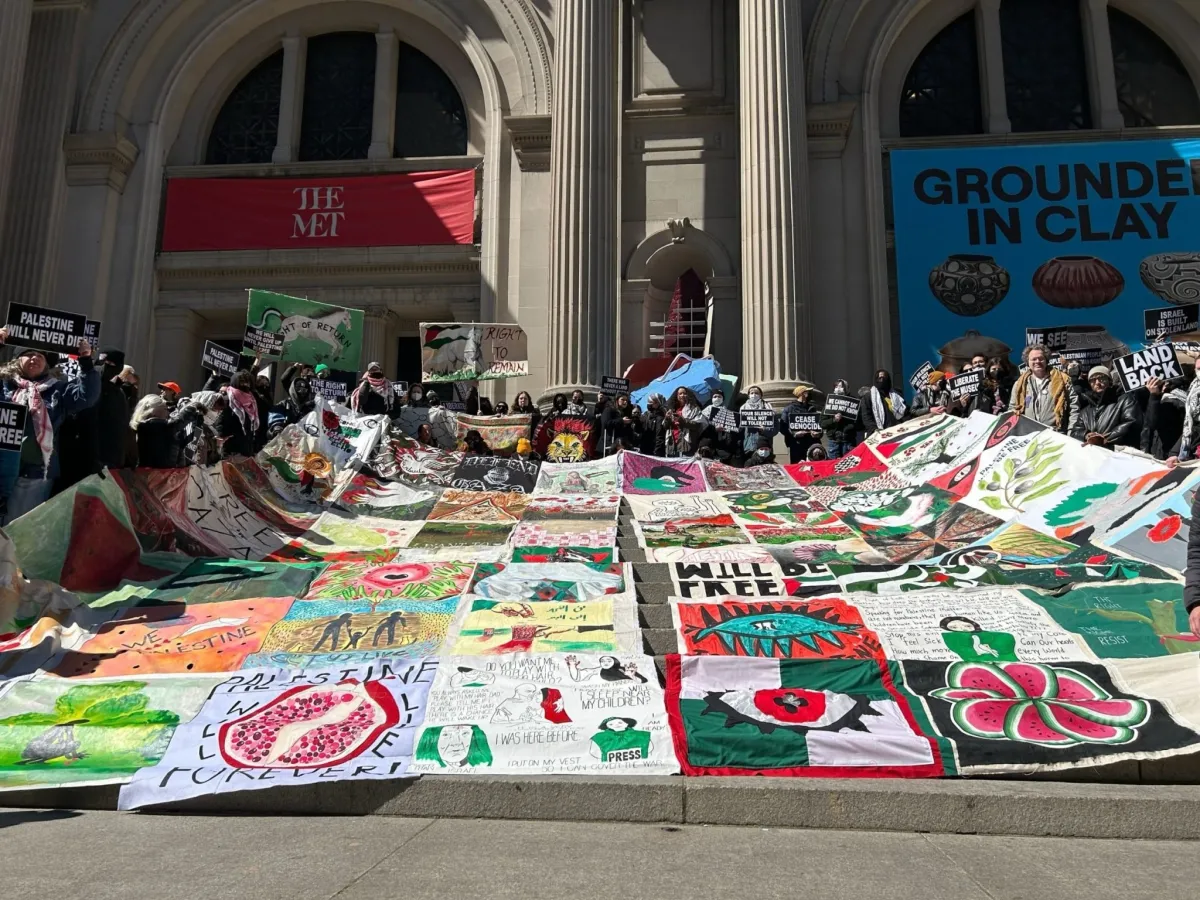Admin note: only New York sections included
Over the last 15 months, artists have mobilized against Israel’s attacks on civilians in Gaza, which organizations including Amnesty International and Human Rights Watch have determined to be consistent with genocide. After multiple failed attempts, Israel and Hamas agreed to a mutually negotiated ceasefire deal that went into effect on Sunday, January 19, with an initial phase stipulating a halt in Israeli attacks on Gaza for six weeks. The deal will reportedly allow humanitarian aid to enter the Gaza Strip as Palestinians are permitted to return to their locales and Israeli hostages and Palestinian prisoners will be released in stages. Still fragile as it unfolds day by day, the US-backed ceasefire deal marks a precarious break in the onslaught of violence and destruction throughout Gaza. On Monday, January 27, tens of thousands of displaced Gazans began to return north.
In their international push for a permanent ceasefire, artists have developed visual languages to demand institutional divestments from Israel and call for an end to violence against Palestinians in Gaza and the Occupied West Bank. Many have either foregone or been denied life-changing career opportunities in their public advocacy for Palestine, underscoring the importance of community, solidarity, and artistic freedom in the broader culture sector.
Below are some of the most impactful moments of artistic protest for Gaza since October 2023.

Hundreds of protesters took to the steps of the Metropolitan Museum of Art last March to unfurl an enormous collaborative quilt made up of nearly 70 individual canvas squares painted by artists in support of Palestine. Channeling the NAMES Project AIDS Memorial Quilt, the collaborative project titled “From Occupation to Liberation” was also accompanied by custom-printed mock museum guides calling attention to The Met trustees and donors’ ties to Israeli violence.
The action came less than a week after over 150 Met staff members signed an open letter calling on Museum Director and CEO Max Hollein to issue a statement in support of a ceasefire and address Israel’s attacks on Gaza. Anonymous statements from the artists of the original squares can be found here.
ACT UP Triangle for Gaza Solidarity

“SILENCE = DEATH imagery pissed people off when it was created, but it was effective and now an iconic symbol of how world governments failed us throughout the ongoing AIDS crisis,” Escarciga told Hyperallergic at the time. Escarciga and the organization drew attention to the threat of federal spending cuts for HIV research in conjunction with the billions of US dollars being set aside for military spending in Israel, reiterating ACT UP’s core message: “FUND HEALTHCARE, NOT WARFARE! PERMANENT CEASEFIRE NOW!”
Hind’s Hall Protest Banner

Before student protesters occupied Columbia University’s Hamilton Hall, which was later raided by the New York Police Department in April 2024, a group of about 70 artists was hard at work creating the signage that would come to represent the nationwide university protest movement. Images of the “Hind’s Hall” banner that turned an academic building into a tribute to Hind Rijab, a Palestinian child killed by Israeli forces in early 2024, were widely reproduced, and the action inspired a song of the same name by the rapper Macklemore.
“Speaking through our artwork in our signage is the best way to just make and assert our message clearly, concisely and not have it be filtered or edited,” Layal, a Columbia University undergraduate affiliated with the arts wing of Columbia University Apartheid Divest, told Hyperallergic in June. Students also adopted a “Liberated Zone” banner to label their encampment, a visual callback to the university’s 1968 student civil rights protests.
Thousands Channel Young Lords in “Dump AIPAC” Protest

Channeling the Young Lords’s historic “Garbage Offensive” of 1969, thousands of Jewish Voice for Peace (JVP) activists and allies marched through Manhattan from the United Nations headquarters to the American Israel Public Affairs Committee’s (AIPAC) office in Midtown on February 22, 2024. Sparked by the US’s third consecutive veto of the United Nations Security Council’s draft ceasefire resolution two days prior, JVP called on Congressman Hakeem Jeffries as well as Senators Chuck Schumer and Kirsten Gillibrand to “dump AIPAC,” a reference to the Young Lords’s iconic demonstrations against inadequate sanitation services affecting Puerto Rican and Latine communities in New York City.
Equipped with enormous red letters that spelled out “DUMP AIPAC” and dozens of red garbage bags emblazoned with the same message, JVP organizers led the march from the organization’s headquarters to Schumer’s and Gillibrand’s office, where dozens of Jewish protesters staged a sit-in at the lobby and 18 were arrested after refusing to vacate.
New York (War) Crimes Broadsheets

This was the first of multiple installments of New York (War) Crimes — now a bi-monthly publication criticizing the NYT’s alleged bias toward the Israeli military and calling on subscribers to cancel their memberships to the media outlet. Published by the Writers Against the War on Gaza, editions of the paper are often found at various pro-Palestine demonstrations throughout the city.
“Handala of Liberty” Artwork

In this artwork, Ridikkuluz portrays the Statue of Liberty, a symbol of American freedom, wearing a keffiyeh and posing like Handala. “The pacifist gesture of putting your hands behind your back as your world blows up in flames is the Palestinian resistance personified,” Ridikkuluz told Hyperallergic in an email last January.
“Free Palestine” Banner Drop Shutters Museum of Modern Art

Several large protest banners complemented Carolina Caycedo’s works floating above the Museum of Modern Art’s (MoMA) second-floor atrium as some 800 protesters infiltrated the museum for an enormous pro-Palestine sit-in leading to the museum’s early closure for the rest of the day. Alongside the banner drops, the organizers called targeted five MoMA board members for their financial and corporate investments in Israeli military weaponry, surveillance technology, and the fossil fuel industry and drew attention to the museum’s institutional silence on the bombardment on Gaza through custom-printed mock museum pamphlets, chants, and speeches.
“Forbidden Protest Sign” (2023) at NYC’s HOME Gallery

Hyperallergic Editor-in-Chief Hrag Vartanian created “Forbidden Protest Sign” (2023) for HOME gallery, a storefront exhibition space formerly run by William Chan on Grand Street in Manhattan, after originally planning to work on a piece about the blockade of Artsakh. “Sadly, the dictatorship of Azerbaijan attacked and forced out the 100,000+ indigenous residents in September 2023, emptying the area of its Armenian population for the first time in recorded history,” Vartanian remarked. He ultimately decided to display “Forbidden Protest Sign,” describing the mural as “about those things in democratic societies that are often curtailed and banned for various reasons.”
Chan told Hyperallergic in an email that the installation rose to the moment in October 2023, when “any criticism of the Israeli offensive was met with intense pushback.”
“The size and accessibility at street level, coupled with the high traffic, made this work one of the most powerful and influential statements on October 7 and its aftermath,” Chan said.
20,000 Poppies at the New York Stock Exchange

On December 15, 2023, a group of nearly 30 artists and activists placed some 20,000 paper poppy flowers in front of the New York Stock Exchange in Lower Manhattan. Each poppy symbolized the rising death toll in Gaza in the third month of Israel’s bombardment. One artist told Hyperallergic the display was a reference to Felix González-Torres’s “Untitled (Portrait of Ross in L.A.),” which consisted of 175 pounds of wrapped candy, the average weight of an adult male, and was created in 1991, the year the artist’s partner, Ross Laycock, died from AIDS complications.
“A public display of these handmade paper poppies is meant to recall that feeling of loss,” Ariel Friedlander, an artist and member of Jewish Voice for Peace and ACT UP, told Hyperallergic in December 2023. “And of another government-sanctioned tragedy.” The poppy is also a symbol of Palestine and has been referenced in other protest actions, including during a disruption of Israeli artist Michael Rovner’s Pace Gallery opening last March.
Source: Hyperallergic

